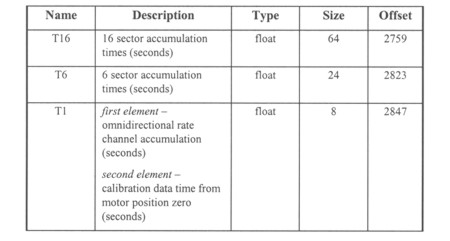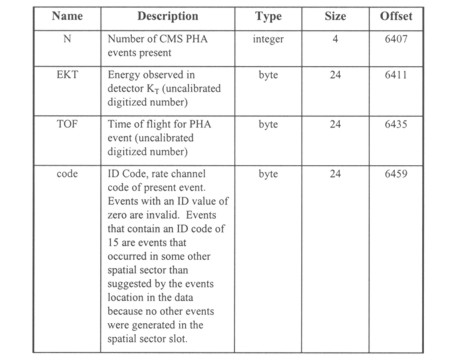The Galileo Energetic Particles Detector
Galileo EPD Handbook
Chapter 2. EPD Software
LGA Processing Software for the Energetic Particles Detector (continued)
Source: C. Brull and S. Stone, December 19, 1998
3. LGA Processor Outputs (continued)
3.3 Time Accumulation Block (96 bytes)
The time accumulation arrays T16[16], T6[6], and T1[2] contain the accumulation times in seconds corresponding to the channel rate data described in section 3.2.

3.4 Uncertainty Vector Block (2369 bytes)
The arrays E16[16][16], E6[40][6], and E1[48][2] contain the systematic (log compression) and statistical uncertainties corresponding to the channel rate described in section 3.2. Uncertainties are given in counts per second.

3.5 Data Quality Block (1184 bytes)
The arrays DQF16[16][16], DQF6[40][6], and DQF[48][2] are short integers containing the encoded data quality flags for all channels. Preliminary flags are defined in Note 3.

3.6 PHA Events (76 bytes)
A concatenated list of N events where N is determined by the observation time. Calibrations for EKT and TOF will be furnished at some later time.

3.7 Spares (401 bytes)

TOTAL RECORD SIZE: 6884 BYTES
Next: 4. LGA Processor Overview
Return to Galileo EPD Handbook Table of Contents Page.
Return to main
Galileo Table of Contents Page.
Return to Fundamental
Technologies Home Page.
Updated 8/23/19, Cameron Crane
QUICK FACTS
Mission Duration: Galileo was planned to have a mission duration of around 8 years, but was kept in operation for 13 years, 11 months, and 3 days, until it was destroyed in a controlled impact with Jupiter on September 21, 2003.
Destination: Galileo's destination was Jupiter and its moons, which it orbitted for 7 years, 9 months, and 13 days.



